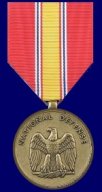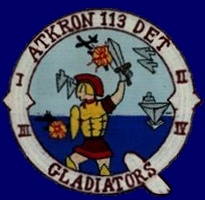|
VA-113 DET-Q    March 22, 1965 - October 7, 1965 |
|
VA-113 DET-Q    March 22, 1965 - October 7, 1965 |
USS
Bennington (CVS 20) and
USS
Hoel (DDG-13) Operations
| CHICAGO TRIBUNE, SUNDAY,
JUNE 6, 1965
Writer Finds navy Role in Viet Complex Reports 7th Fleet Maneuvers in China Sea
With U. S. 7th Fleet, June 5- -At Da Nang, marines sharing holes dug into the surrounding hills guard the American air base. But out here in the China sea, the task of protecting the carriers of the 7th fleet is a bit more complex. It requires ships like the Bennington and the Hoel. All together, the fleet has 130 ships, with 40,000 sailors. The Bennington, as a World War II carrier, helped regain Wake Island, sank the last Japanese battleship, the Yamato, and joined in the victory air parade that filled the sky over Tokyo harbor when Gen. Douglas MacArthur accepted the Japanese surrender. She is back in the Pacific now redesigned and reequipped to fight any communist submarines which might tackle the 7th fleet. North Viet Nam currently poses no such threat but many of the Soviet Union's 600 submarines are in the Pacific and Russian trawlers prowl the China sea and its approaches. Searches Out Subs
The fliers call themselves the Restless Tigers of the Pacific. The planes twin engined, long endurance craft called Trackers, trail a kind of horizontal flag pole, which, by making use of iron's attraction to a magnet, picks out subs that might even be silently lying on the sea bottom thwarting fleet's sound detection equipment. The Bennington's helicopters, driven by two jet turbines, hold the world speed record but, more important for the Bennington's purposes, they can stand still for four hours so barely above the waves, dangling sound equipment in the water. Saves Two Pilots
The Bennington has yet to launch any weapon in earnest, but one of the helicopter pilots, Lt. David Zane North Merrick N. Y., already has two rescues to his credit. He picked up a flyer from the carrier Midway and also one of the Bennington's own fliers, Lt. Mark Pierce, whose Skyhawk jet interceptor slipped over the side while landing in rough weather. The landing cable held the plane fast, dunking only the nose and cockpit in the water. Pierce freed himself, floated from the cockpit and was back on the ship in less than a minute. The Bennington, to indicate the change in weapons over the years, carries only four guns. Her namesake, built in 1891 as a sailing schooner, had six. The Bennington's Executive officer, Cmdr. Donald Monson, is from Downers Grove. Ted Naleck, 4137 N. Dickinson, and Larry Bale, Mason City, Ia. work in dental surgery. Barry Bishop, Rockford, I1l., helps keep the hundreds of phones working. Larry Stevens. Rockfalls, Ill., can sometimes be found chipping paint, an endless task, and Carl Snyder, Plymouth, Ill., refuels planes. Jimmie Burns, Dongola, Ill., is a marine guard. The Hoel is one of the fleet's newest ships. Tho called a destroyer, her main weapons are missiles that can be fired at planes, at targets in the air, on land or sea or underwater. She has fired 26 missiles during her first three years, but only in practice. Studied at Purdue
Radar finds and tracks would-be attackers. In the half darkened control room, walled with black glass, sailors chalk up a mass of ever-changing details giving the commander, at a glance, a picture of an area, say, 50 miles or more around him. The commander selects the target. Data on its incoming paths is automatically fed by the radar into the missile controls, adjusting its flight orders to fit the path of the attacker. The missile is fired by hand. To do so, Lt. Wienandt pushes a button on a pistol grip handle. By then, round doors over the upright storage tubes on the rear deck have opened, and the missiles pop up two at a time, been gripped in steel claws, pointed and tilted in the right direction. The lieutenant can fire missiles separately or in pairs. Each shot costs 40,000 dollars. As soon as two are gone, two more pop up. If the attacker changes course after the missile is fired, the missile also changes courses. Protects Midway's Planes For 35 recent days, the Hoel was part of the close-in support for the carrier Midway, busy sending planes into North Viet Nam. The task required accurate navigation, for the Hoel often acted as an aerial gateway for the carrier, checking planes returning to the ship to make certain no enemy craft slipped into the landing pattern. John Bell, Munster, Ind., is one of the navigation teams. Fred Ahrens, 14223 Dearborn, Riverdale, Ill., is an engineer, and Jarrold Clements, Oshkosh, Wis., is a medic with 11 years experience patching up sailors after minor accidents and ailments. The Hoel, tho primarily an anti-aircraft ship, hunts submarines as a sideline. Frederick Graft, St. Louis, was given a 32-week course at San Diego so he could help tend the elaborate sound equipment. Lewis Waltz, Hanover, Ill., is also an anti-submarine man. The Hoel is the second destroyer
to bear the name of the Civil war hero, William Hoel, who led federal gunships
around a Mississippi island rebel fortress. The first Hoel went down with
almost all hands in October of 1944 fighting off Japanese battleships attacking
carriers off the Philippine Island of Samar.
|
|
When Va-113 Det Q returned to the United States, it disbanded and merged
with Antisubmarine Warfare
Fighter Squadron One (VSF-1).
The newly formed Squadron was stationed at Naval Air Station Alameda on the beautiful San Francisco Bay. |
| Site
Search
|
Support
the NAS Alameda Naval Air Museum and the USS Hornet Museum
bswanson7@sbcglobal.net
|